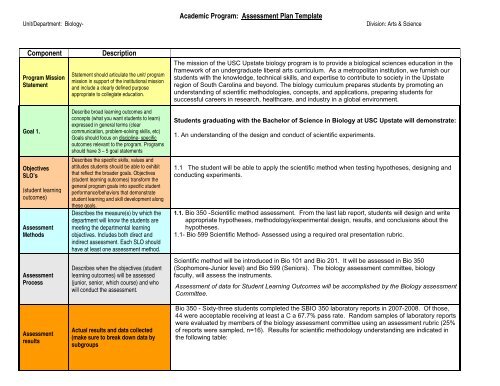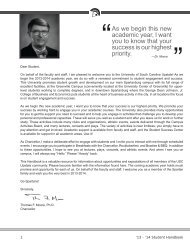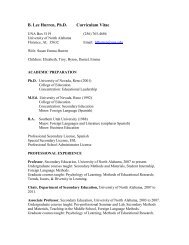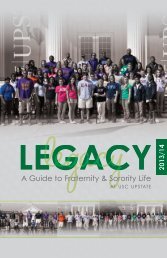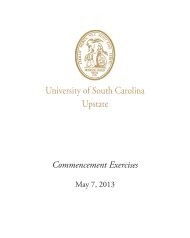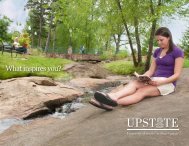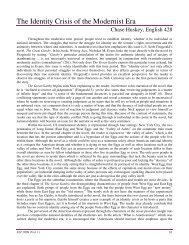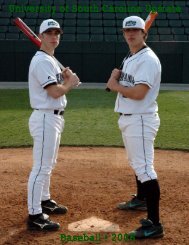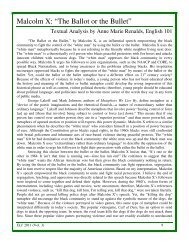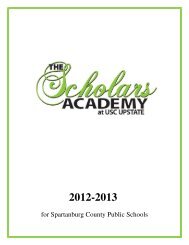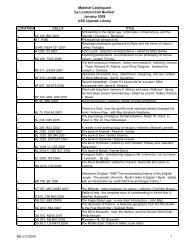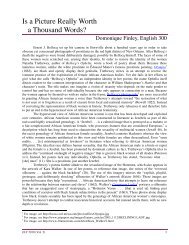Academic Program: Assessment Plan Template - University of South ...
Academic Program: Assessment Plan Template - University of South ...
Academic Program: Assessment Plan Template - University of South ...
You also want an ePaper? Increase the reach of your titles
YUMPU automatically turns print PDFs into web optimized ePapers that Google loves.
<strong>Academic</strong> <strong>Program</strong>: <strong>Assessment</strong> <strong>Plan</strong> <strong>Template</strong><br />
Unit/Department: Biology- Division: Arts & Science<br />
Component Description<br />
<strong>Program</strong> Mission<br />
Statement<br />
Statement should articulate the unit/ program<br />
mission in support <strong>of</strong> the institutional mission<br />
and include a clearly defined purpose<br />
appropriate to collegiate education.<br />
The mission <strong>of</strong> the USC Upstate biology program is to provide a biological sciences education in the<br />
framework <strong>of</strong> an undergraduate liberal arts curriculum. As a metropolitan institution, we furnish our<br />
students with the knowledge, technical skills, and expertise to contribute to society in the Upstate<br />
region <strong>of</strong> <strong>South</strong> Carolina and beyond. The biology curriculum prepares students by promoting an<br />
understanding <strong>of</strong> scientific methodologies, concepts, and applications, preparing students for<br />
successful careers in research, healthcare, and industry in a global environment.<br />
Goal 1.<br />
Objectives<br />
SLO’s<br />
(student learning<br />
outcomes)<br />
<strong>Assessment</strong><br />
Methods<br />
<strong>Assessment</strong><br />
Process<br />
<strong>Assessment</strong><br />
results<br />
Describe broad learning outcomes and<br />
concepts (what you want students to learn)<br />
expressed in general terms (clear<br />
communication, problem-solving skills, etc)<br />
Goals should focus on discipline- specific<br />
outcomes relevant to the program. <strong>Program</strong>s<br />
should have 3 – 5 goal statements<br />
Describes the specific skills, values and<br />
attitudes students should be able to exhibit<br />
that reflect the broader goals. Objectives<br />
(student learning outcomes) transform the<br />
general program goals into specific student<br />
performance/behaviors that demonstrate<br />
student learning and skill development along<br />
these goals.<br />
Describes the measure(s) by which the<br />
department will know the students are<br />
meeting the departmental learning<br />
objectives. Includes both direct and<br />
indirect assessment. Each SLO should<br />
have at least one assessment method.<br />
Describes when the objectives (student<br />
learning outcomes) will be assessed<br />
(junior, senior, which course) and who<br />
will conduct the assessment.<br />
Actual results and data collected<br />
(make sure to break down data by<br />
subgroups<br />
Students graduating with the Bachelor <strong>of</strong> Science in Biology at USC Upstate will demonstrate:<br />
1. An understanding <strong>of</strong> the design and conduct <strong>of</strong> scientific experiments.<br />
1.1 The student will be able to apply the scientific method when testing hypotheses, designing and<br />
conducting experiments.<br />
1.1. Bio 350 -Scientific method assessment. From the last lab report, students will design and write<br />
appropriate hypotheses, methodology/experimental design, results, and conclusions about the<br />
hypotheses.<br />
1.1- Bio 599 Scientific Method- Assessed using a required oral presentation rubric.<br />
Scientific method will be introduced in Bio 101 and Bio 201. It will be assessed in Bio 350<br />
(Sophomore-Junior level) and Bio 599 (Seniors). The biology assessment committee, biology<br />
faculty, will assess the instruments.<br />
<strong>Assessment</strong> <strong>of</strong> data for Student Learning Outcomes will be accomplished by the Biology assessment<br />
Committee.<br />
Bio 350 - Sixty-three students completed the SBIO 350 laboratory reports in 2007-2008. Of those,<br />
44 were acceptable receiving at least a C a 67.7% pass rate. Random samples <strong>of</strong> laboratory reports<br />
were evaluated by members <strong>of</strong> the biology assessment committee using an assessment rubric (25%<br />
<strong>of</strong> reports were sampled, n=16). Results for scientific methodology understanding are indicated in<br />
the following table:
<strong>Academic</strong> <strong>Program</strong>: <strong>Assessment</strong> <strong>Plan</strong> <strong>Template</strong><br />
Unit/Department: Biology- Division: Arts & Science<br />
Sci Format<br />
Criteria<br />
Mean Score (0-3) % Acceptable<br />
ORGANIZATION 2.69 90%<br />
MECHANICS 2.31 77%<br />
REFERENCE 2.56 85%<br />
SCIENTIFIC<br />
METHOD<br />
2.56 85%<br />
STATISTICS USE 2.50 83%<br />
Analysis <strong>of</strong> laboratory reports indicated that majority <strong>of</strong> students demonstrated the ability to<br />
understand and apply the scientific method appropriately (85% successful).<br />
Bio 599-research paper evaluation found that 83% <strong>of</strong> the papers reviewed used the scientific method<br />
appropriately. The rubric from the oral presentation lacks a portion where this evaluation could be<br />
made<br />
Use <strong>of</strong><br />
assessment<br />
results<br />
What actions or modification have<br />
been or will be made based on this<br />
assessment<br />
BIO 350 – Based on assessment results, no course changes are anticipated at this time.<br />
Bio 599 - modify the oral rubric so that evaluation <strong>of</strong> this phase <strong>of</strong> the course can be effectively<br />
evaluated<br />
Goal 2.<br />
Objectives<br />
SLO’s<br />
(student learning<br />
outcomes)<br />
Describe broad learning outcomes and<br />
concepts (what you want students to learn)<br />
expressed in general terms (clear<br />
communication, problem-solving skills, etc)<br />
Goals should focus on discipline- specific<br />
outcomes relevant to the program. <strong>Program</strong>s<br />
should have 3 – 5 goal statements<br />
Describes the specific skills, values and<br />
attitudes students should be able to exhibit<br />
that reflect the broader goals. Objectives<br />
(student learning outcomes) transform the<br />
general program goals into specific student<br />
performance/behaviors that demonstrate<br />
student learning and skill development along<br />
these goals.<br />
Students graduating with the Bachelor <strong>of</strong> Science in Biology at USC Upstate will demonstrate:<br />
2. An understanding <strong>of</strong> important concepts and methods in the biological sciences.<br />
.<br />
2.1 The student will be able to describe the structure and function <strong>of</strong> cellular components.<br />
2.2 The student will be able to discuss and give examples <strong>of</strong> macro and micro evolution.<br />
2.3 The student will be able to explain and recognize interrelationships and dependencies between<br />
abiotic and biotic components <strong>of</strong> ecosystems
<strong>Academic</strong> <strong>Program</strong>: <strong>Assessment</strong> <strong>Plan</strong> <strong>Template</strong><br />
Unit/Department: Biology- Division: Arts & Science<br />
2.1 Bio 202- Structural and cellular components: Exam questions will assess students’ knowledge <strong>of</strong><br />
these concepts. They will appear on a regular in-class test and their scores will be compared to<br />
a pre-test given at the beginning <strong>of</strong> the semester which tests their knowledge <strong>of</strong> the basic<br />
concepts covered in BIO 101 and 102 that relate to BIO 202.<br />
<strong>Assessment</strong><br />
Methods<br />
<strong>Assessment</strong><br />
Process<br />
<strong>Assessment</strong><br />
results<br />
Describes the measure(s) by which the<br />
department will know the students are<br />
meeting the departmental learning<br />
objectives. Includes both direct and<br />
indirect assessment.<br />
Each SLO should have at least one<br />
assessment method.<br />
Describes when the objectives (student<br />
learning outcomes) will be assessed<br />
(junior, senior, which course) and who<br />
will conduct the assessment.<br />
Actual results and data collected<br />
(make sure to break down data by<br />
subgroups<br />
2.2 Bio 201-Macroevolution assessment methods:<br />
1. A set <strong>of</strong> Lecture exam questions will assess the student learning outcome.<br />
Bio 201 - Microevolution assessment methods:<br />
1. A set <strong>of</strong> Lecture exam questions on this topic will assess this SLO<br />
2.3 Bio 201 will be assessed using<br />
1. a set <strong>of</strong> Lecture exam questions<br />
2.1 – 2.3 Bio 599 The standardized national Major Field <strong>Assessment</strong> Test (MFAT) will be used to<br />
assess the SLO content/concept knowledge for biology seniors. Results will be used to adjust<br />
course and curricular content <strong>of</strong>ferings as required.<br />
2.1 Structural and cellular components will be introduced in Bio 101 and assessed in Bio 202.<br />
2.2 Macro and micro evolution will be assessed in Bio 201.<br />
2.3 The interrelationships and dependencies between abiotic and biotic components <strong>of</strong> ecosystems<br />
will be assessed in Bio 201.<br />
2.4 The students will be compared to the National Average using the MFAT. 75% <strong>of</strong> the seniors<br />
should be at or above the National Average on the four sections <strong>of</strong> the exam.<br />
<strong>Assessment</strong> <strong>of</strong> data for Student Learning Outcomes will be accomplished by the Biology assessment<br />
Committee.<br />
Cell Biology<br />
Organismal Biology<br />
Molecular and Genetics<br />
Ecology<br />
Overall<br />
Fall 2007 N=15 Spring 2008 N=30<br />
33% lower than 1 std dev unit from 30% lower than 1 std dev unit from<br />
the National mean<br />
the National mean<br />
13% lower than 1 std dev unit from 20% lower than 1 std dev unit from<br />
the National mean<br />
the National mean<br />
20% lower than 1 std dev unit from 0% lower than 1 std dev unit from the<br />
the National mean<br />
National mean<br />
33% lower than 1 std dev unit from 23% lower than 1 std dev unit from<br />
the National mean<br />
the National mean<br />
13% lower than 1 std dev unit from 7% lower than 1 std dev unit from the<br />
the National mean<br />
National mean<br />
13 % scored higher than National 6% scored higher than the National<br />
means plus 1 Std. Deviation unit mean plus 1 Std. Deviation unit<br />
87 % were within in the National 93% scored within the National mean<br />
mean or higher<br />
or higher
<strong>Academic</strong> <strong>Program</strong>: <strong>Assessment</strong> <strong>Plan</strong> <strong>Template</strong><br />
Unit/Department: Biology- Division: Arts & Science<br />
2.4 MFAT is divided into 4 sections cell biology, molecular and Genetics, organism biology, and<br />
Ecology and evolution. This table shows the results <strong>of</strong> 2 different semesters results Fall 2007 and<br />
Spring 2008. In each category USC Upstate Biology Senior were compared with the National Mean<br />
=/- the National Standard Deviation (Std. Dev.)<br />
2.2/2.3 Results from Biology 201 assessment <strong>of</strong> Macro evolution and understanding biotic and<br />
abiotic components <strong>of</strong> ecosystems (see Table 1).<br />
Table 1. Evaluation <strong>of</strong> student understanding <strong>of</strong> macroevolution (Objective 2.2 for Biology).<br />
<strong>Assessment</strong> Method: Number <strong>of</strong> students evaluated: Average score:<br />
Fall 2006:<br />
Lecture Exam 44 70%<br />
Lab Quiz 27 81%<br />
Fall 2007:<br />
Lecture Exam 56 73%<br />
Lab Quiz 58 76%<br />
Spring 2008:<br />
Lecture Exam 17 75%<br />
Lab Quiz 19 71%<br />
Total for all semesters:<br />
Lecture Exam 117 72%<br />
Lab Quiz 104 76%<br />
Table 2. Evaluation <strong>of</strong> student understanding <strong>of</strong> microevolution (Objective 2.2 for Biology).<br />
<strong>Assessment</strong> Method: Number <strong>of</strong> students evaluated: Average score:<br />
Fall 2006:<br />
Lecture Exam 44 69%<br />
Lab Quiz 41 68%<br />
Fall 2007:<br />
Lecture Exam 55 70%<br />
Lab Quiz 57 92%<br />
Spring 2008:<br />
Lecture Exam 55 75%<br />
Lab Quiz 14 67%<br />
Total for all semesters:<br />
Lecture Exam 116 71%<br />
Lab Quiz 112 82%<br />
Table 3. Evaluation <strong>of</strong> student understanding <strong>of</strong> abiotic and biotic influences on ecosysytems (Objective 2.5 for
<strong>Academic</strong> <strong>Program</strong>: <strong>Assessment</strong> <strong>Plan</strong> <strong>Template</strong><br />
Unit/Department: Biology- Division: Arts & Science<br />
Biology).<br />
<strong>Assessment</strong> Method: Number <strong>of</strong> students evaluated: Average score:<br />
Fall 2006:<br />
Lecture Exam 44 81%<br />
Lab Quiz 44 84%<br />
Lab Project 45 75%<br />
Fall 2007:<br />
Lecture Exam 56 85%<br />
Lab Quiz 60 86%<br />
Lab Project 56 70%<br />
Spring 2008:<br />
Lecture Exam 17 72%<br />
Lab Quiz 19 81%<br />
Lab Project 19 70%<br />
Total for all semesters:<br />
Lecture Exam 117 82%<br />
Lab Quiz 123 85%<br />
Lab Project 120 75%<br />
2.12.1 Results from evaluation <strong>of</strong> SLO from Biology 201<br />
1) Prokaryotic and eukaryotic cells generally have which <strong>of</strong> the following features in common?<br />
A) a membrane-bounded nucleus<br />
B) a cell wall made <strong>of</strong> cellulose<br />
Average on pre-test Average on post-test<br />
C) ribosomes<br />
D) flagella or cilia that contain microtubules<br />
E) linear chromosomes made <strong>of</strong> DNA and protein<br />
52 82<br />
2) All <strong>of</strong> the following are part <strong>of</strong> a prokaryotic cell except<br />
A) DNA.<br />
B) a cell wall.<br />
Average on pre-test Average on post-test<br />
C) a plasma membrane.<br />
D) ribosomes.<br />
E) an endoplasmic reticulu<br />
43 71<br />
3) Which <strong>of</strong> the following types <strong>of</strong> molecules are the major structural components <strong>of</strong> the cell<br />
membrane?<br />
A) phospholipids and cellulose<br />
Average on pre-test Average on post-test<br />
B) nucleic acids and proteins<br />
66 86<br />
C) phospholipids and proteins<br />
D) proteins and cellulose<br />
E) glycoproteins and cholesterol<br />
Refer to the following five terms to answer the questions 4-8. Choose the most appropriate term for<br />
each phrase. Each term may be used once, more than once, or not at all.
<strong>Academic</strong> <strong>Program</strong>: <strong>Assessment</strong> <strong>Plan</strong> <strong>Template</strong><br />
Unit/Department: Biology- Division: Arts & Science<br />
A. lysosome D. Golgi apparatus<br />
B. ribosome E. smooth endoplasmic reticulum<br />
C. mitochondrion<br />
4) modifies proteins that will be secreted from<br />
the cell<br />
5) contains hydrolytic enzymes<br />
Average on pre-test<br />
Average on post-test<br />
Q4) 45 82<br />
Q5) 59 86<br />
6) the site <strong>of</strong> protein translation<br />
7) one <strong>of</strong> the main energy transformers <strong>of</strong> cells<br />
8) site <strong>of</strong> lipid synthesis and drug detoxification<br />
Q6) 48 77<br />
Q7) 80 93<br />
Q8) 46 84<br />
Use <strong>of</strong><br />
assessment<br />
results<br />
What actions or modification have<br />
been or will be made based on this<br />
assessment<br />
Overall <strong>Assessment</strong>:<br />
Class average on pretest<br />
post-test<br />
Class average on<br />
55 83<br />
SLO 2.1: The results for SLO 2.1 indicate that students in BIO 202 Spring 2008 scored above 70%<br />
on all eight questions. The average score for these questions was 83%, while on the pre-test, the<br />
average was 55%.<br />
2.1 (BIO 202) - The structural and cellular components were introduced in BIO 101 which is<br />
generally taken during a biology major’s first semester. These concepts are then assessed in BIO<br />
202, usually taken during the major’s fourth semester. Scores from the pre-test indicate that<br />
retention <strong>of</strong> these concepts is generally low coming out <strong>of</strong> BIO 101. Improvement <strong>of</strong> retention after<br />
having the material covered again in BIO 202 is evident from the increase in scores. However, since<br />
these questions are given on the first in-class test, where much <strong>of</strong> the lectures leading up to it have<br />
emphasized these concepts, a more accurate assessment <strong>of</strong> retention <strong>of</strong> this information may be to<br />
include these questions on the comprehensive final exam given two months later. Therefore, in<br />
future <strong>of</strong>ferings <strong>of</strong> this course, the questions will appear on the final exam rather than the first test.<br />
2.4 (BIO 599) MFAT - determine if those individuals who did poorly on a section had the necessary<br />
course work to pass that section. This comparison could be done by checking their academic<br />
record. This should correct itself with the requirement for Biology 201 and 202 required <strong>of</strong> all<br />
biology majors who graduate from USC Upstate. In general students performed better than we<br />
anticipated. This exam was recently changed, making comparison with historical USC Upstate<br />
Biology student performance problematic.
<strong>Academic</strong> <strong>Program</strong>: <strong>Assessment</strong> <strong>Plan</strong> <strong>Template</strong><br />
Unit/Department: Biology- Division: Arts & Science<br />
Goal 3<br />
Objectives<br />
SLO’s<br />
(student learning<br />
outcomes)<br />
<strong>Assessment</strong><br />
Methods<br />
<strong>Assessment</strong><br />
Process<br />
Describe broad learning outcomes and<br />
concepts (what you want students to learn)<br />
expressed in general terms (clear<br />
communication, problem-solving skills, etc)<br />
Goals should focus on discipline- specific<br />
outcomes relevant to the program. <strong>Program</strong>s<br />
should have 3 – 5 goal statements<br />
Describes the specific skills, values and<br />
attitudes students should be able to exhibit<br />
that reflect the broader goals. Objectives<br />
(student learning outcomes) transform the<br />
general program goals into specific student<br />
performance/behaviors that demonstrate<br />
student learning and skill development along<br />
these goals.<br />
Describes the measure(s) by which the<br />
department will know the students are<br />
meeting the departmental learning<br />
objectives. Includes both direct and<br />
indirect assessment.<br />
Each SLO should have at least one<br />
assessment method.<br />
Describes when the objectives (student<br />
learning outcomes) will be assessed<br />
(junior, senior, which course) and who<br />
will conduct the assessment.<br />
Students graduating with the Bachelor <strong>of</strong> Science in Biology at USC Upstate will demonstrate:<br />
3. Knowledge <strong>of</strong> and skill utilizing appropriate laboratory techniques in the biological sciences.<br />
3.1 The student will demonstrate certain laboratory techniques (such as light microscopy, gel<br />
electrophoresis, population sampling, aseptic techniques, micro and macro pipetting).<br />
3.1 Bio 350 - Laboratory Techniques <strong>Assessment</strong>: Laboratory technique pertinent to genetics<br />
experimentation will be graded. Lab book will also be assessed.<br />
3.1 Laboratory techniques will be introduced in Bio 101, Bio 102, and Bio 201. They will be<br />
assessed in Bio 350.<br />
<strong>Assessment</strong> <strong>of</strong> data for Student Learning Outcomes will be accomplished by the Biology assessment<br />
Committee.<br />
<strong>Assessment</strong><br />
results<br />
Actual results and data collected<br />
(make sure to break down data by<br />
subgroups<br />
3.1 Students ability to pour gels, load samples into gels, conduct protein electrophoresis, conduct<br />
DNA digestion and electrophoresis, and aseptic technique (using bacteria) was evaluated<br />
during their performance <strong>of</strong> each laboratory activity. Between 62 and 69 students were<br />
evaluated in 2007-08 (numbers varied based on attendance in each lab), and 100% <strong>of</strong> the<br />
students showed appropriate technique in all but DNA digestion and electrophoresis. For that<br />
technique, 78.5% showed appropriate technique (51 <strong>of</strong> 65). The only extensive microscopy<br />
work is with dissecting microscopes. All students successfully used the dissecting microscope
<strong>Academic</strong> <strong>Program</strong>: <strong>Assessment</strong> <strong>Plan</strong> <strong>Template</strong><br />
Unit/Department: Biology- Division: Arts & Science<br />
Use <strong>of</strong><br />
assessment<br />
results<br />
What actions or modification have<br />
been or will be made based on this<br />
assessment<br />
3.1 At this time, given the assessment results, no program/course modifications are anticipated.
<strong>Academic</strong> <strong>Program</strong>: <strong>Assessment</strong> <strong>Plan</strong> <strong>Template</strong><br />
Unit/Department: Biology- Division: Arts & Science<br />
Goal 4<br />
Describe broad learning outcomes and concepts (what you<br />
want students to learn) expressed in general terms (clear<br />
communication, problem-solving skills, etc) Goals should<br />
focus on discipline- specific outcomes relevant to the<br />
program. <strong>Program</strong>s should have 3 – 5 goal statements<br />
Students graduating with the Bachelor <strong>of</strong> Science in Biology at USC Upstate will<br />
demonstrate:<br />
1. An ability to critically analyze, evaluate and interpret scientific information.<br />
Objectives<br />
SLO’s<br />
(student learning<br />
outcomes)<br />
<strong>Assessment</strong><br />
Methods<br />
<strong>Assessment</strong><br />
results<br />
Describes the specific skills, values and attitudes students<br />
should be able to exhibit that reflect the broader goals.<br />
Objectives (student learning outcomes) transform the<br />
general program goals into specific student<br />
performance/behaviors that demonstrate student learning<br />
and skill development along these goals.<br />
Describes the measure(s) by which the department<br />
will know the students are meeting the departmental<br />
learning objectives. Includes both direct and indirect<br />
assessment.<br />
Each SLO should have at least one assessment<br />
method.<br />
Actual results and data collected (make sure to<br />
break down data by subgroups<br />
4.1 The student will be able to access, recognize, summarize and critically analyze primary<br />
literature.<br />
4.2 The student will be able to apply and interpret descriptive and inferential statistics<br />
4.1 Bio 599 - This SLO will be assessed using a required research paper and an oral<br />
presentation that will be evaluated by a rubric.<br />
4.2 Bio 350 – This SLO will be assessed using a required research paper and an oral<br />
presentation that will be evaluated by a rubric.<br />
4.1 – BIO 599 This was assessed using the research paper required in Biology 599. Using a<br />
rubric which evaluated the following items: organization, mechanics, reference utilization and<br />
scientific method a sub sample <strong>of</strong> the 45 paper (N=12) from fall 07 and spring 08 were<br />
evaluated. Each <strong>of</strong> the papers received an excellent (3 pts.), satisfactory (2 pts), or<br />
unsatisfactory (1 pt.) in each <strong>of</strong> the categories. In the use <strong>of</strong> the scientific method 82 %<br />
received a Satisfactory or better with 25% receiving an excellent. Seventeen percent (17%)<br />
received an unsatisfactory. This exceeds our 75% goal.<br />
4.1 - BIO 599 Seminar in Fall 2007 and spring 2008 had 45 students <strong>of</strong> these 96% received a<br />
satisfactory or better (70%) grade on their presentation with 58 % receiving greater than<br />
85% on their presentation. 38% receiving 70-85 % and only 4% receiving > 70% on their oral<br />
presentation.<br />
4.2 – BIO 350 Sixty-three students completed the SBIO 350 laboratory reports in 2007-2008.<br />
Of those, 44 were acceptable receiving at least a C a 67.7% pass rate. Random samples <strong>of</strong><br />
laboratory reports were evaluated by members <strong>of</strong> the biology assessment committee using an<br />
assessment rubric (25% <strong>of</strong> reports were sampled, n=16). Results were:
<strong>Academic</strong> <strong>Program</strong>: <strong>Assessment</strong> <strong>Plan</strong> <strong>Template</strong><br />
Unit/Department: Biology- Division: Arts & Science<br />
Sci Format<br />
Criteria<br />
Mean Score (0-3) % Acceptable<br />
ORGANIZATION 2.69 90%<br />
MECHANICS 2.31 77%<br />
REFERENCE 2.56 85%<br />
SCIENTIFIC<br />
METHOD<br />
2.56 85%<br />
STATISTICS<br />
USE<br />
2.50 83%<br />
Analysis <strong>of</strong> laboratory reports indicated that majority <strong>of</strong> students demonstrated the ability to<br />
utilize statistics effectively in their laboratory report (83% successful).<br />
Use <strong>of</strong><br />
assessment<br />
results<br />
<strong>Assessment</strong><br />
Process<br />
What actions or modification have been or will be<br />
made based on this assessment<br />
Describes when the objectives (student learning<br />
outcomes) will be assessed (junior, senior, which<br />
course) and who will conduct the assessment.<br />
4.1. If the oral presentation is going to be used to evaluate this category we will need to<br />
redesign the oral presentation rubric. There was not standard rubric used in 2007-08 for<br />
assessing the oral presentations. Eighty-three percent <strong>of</strong> the written papers that were<br />
evaluated exceeded our target <strong>of</strong> 75% competency in understanding and analyzing scientific<br />
literature.<br />
A new oral presentation rubric will be designed and used across multiple course (Bio 599)<br />
sections.<br />
4.1 Accessing, recognizing, summarizing and critically analyzing primary literature will be<br />
introduced in Bio 201 and Bio 202. It will assess in Bio 599.<br />
4.2 Applying and interpreting descriptive and inferential statistics will be introduced in Bio 201<br />
and Bio 350. It will be assessed in Bio 350.<br />
<strong>Assessment</strong> <strong>of</strong> data for Student Learning Outcomes will be accomplished by the Biology<br />
assessment Committee.<br />
Goal 5<br />
Describe broad learning outcomes and concepts (what you<br />
want students to learn) expressed in general terms (clear<br />
communication, problem-solving skills, etc) Goals should<br />
focus on discipline- specific outcomes relevant to the<br />
program. <strong>Program</strong>s should have 3 – 5 goal statements<br />
Students graduating with the Bachelor <strong>of</strong> Science in Biology at USC Upstate will<br />
demonstrate:<br />
5.1 Effective communication skills.<br />
Objectives<br />
SLO’s<br />
(student learning<br />
outcomes)<br />
Describes the specific skills, values and attitudes students<br />
should be able to exhibit that reflect the broader goals.<br />
Objectives (student learning outcomes) transform the<br />
general program goals into specific student<br />
performance/behaviors that demonstrate student learning<br />
and skill development along these goals.<br />
5.1 The student will prepare oral and written reports in a standard scientific format.
<strong>Academic</strong> <strong>Program</strong>: <strong>Assessment</strong> <strong>Plan</strong> <strong>Template</strong><br />
Unit/Department: Biology- Division: Arts & Science<br />
5.1 Bio 350 - Written reports in scientific format: The last lab report, structure <strong>of</strong> paper and<br />
appropriate use <strong>of</strong> the different sections <strong>of</strong> paper will be evaluated.<br />
<strong>Assessment</strong><br />
Methods<br />
Describes the measure(s) by which the department<br />
will know the students are meeting the departmental<br />
learning objectives. Includes both direct and indirect<br />
assessment.<br />
Each SLO should have at least one assessment<br />
method.<br />
5.1 Bio 599- This SLO will be assessed using a required research paper and an oral<br />
presentation that will be evaluated by a rubric.<br />
5.1 Bio 599- This SLO will be assessed using a required research paper and an oral<br />
presentation that will be evaluated by a rubric.<br />
<strong>Assessment</strong><br />
Process<br />
Describes when the objectives (student learning<br />
outcomes) will be assessed (junior, senior, which<br />
course) and who will conduct the assessment.<br />
5.1 Written reports in standard scientific format will be introduced in Bio 102 and Bio 201.<br />
They will be assessed in Bio 350 and Bio 599.<br />
<strong>Assessment</strong> <strong>of</strong> data for Student Learning Outcomes will be accomplished by the Biology<br />
assessment Committee.<br />
<strong>Assessment</strong><br />
results<br />
Actual results and data collected (make sure to<br />
break down data by subgroups<br />
5.1 – (BIO 350) Sixty-three students completed the SBIO 350 laboratory reports in 2007-2008.<br />
Of those, 44 were acceptable receiving at least a C a 67.7% pass rate. Random samples <strong>of</strong><br />
laboratory reports were evaluated by members <strong>of</strong> the biology assessment committee using an<br />
assessment rubric (25% <strong>of</strong> reports were sampled, n=16). Results were:<br />
Sci Format<br />
Criteria<br />
Mean Score (0-3) % Acceptable<br />
ORGANIZATION 2.69 90%<br />
MECHANICS 2.31 77%<br />
REFERENCE 2.56 85%<br />
SCIENTIFIC<br />
METHOD<br />
2.56 85%<br />
STATISTICS USE 2.50 83%<br />
Analysis <strong>of</strong> laboratory reports indicated that majority <strong>of</strong> students demonstrated the ability to<br />
communicate effectively through their writing (70% successful).<br />
5.1 (Bio 599) Senior Seminar a random selection <strong>of</strong> papers from the fall 07 and spring 08 were<br />
evaluated using the attached rubric. From the 45 papers 10 were selected by removing the<br />
title sheet, turning them up side down, and then selecting every 5th paper until 10 were<br />
selected. These were evaluated by 2 faculty members, each received 5 papers.<br />
Categories Excellent (3 pts) Satisfactory (2 pts.) Unsatisfactory (1 pt.)<br />
Organization 17% 83% 0%<br />
Mechanics 8% 66% 25%<br />
Reference usage 17% 58% 25%<br />
Scientific Method 25% 58% 17%<br />
Overall 25% (>10 pts.) 42% (7-9) 33% (
<strong>Academic</strong> <strong>Program</strong>: <strong>Assessment</strong> <strong>Plan</strong> <strong>Template</strong><br />
Unit/Department: Biology- Division: Arts & Science<br />
Use <strong>of</strong><br />
assessment<br />
results<br />
What actions or modification have been or will be<br />
made based on this assessment<br />
There are several courses where students write papers and use the literature besides Bio 599<br />
the department will put more emphasis in those courses as well as more emphasis in senior<br />
seminar. Additionally, everyone who requires student papers will be encouraged to use a<br />
similar rubric.<br />
How will<br />
assessment<br />
results be<br />
used?<br />
Describes what will be done with the data that is<br />
collected and analyzed. (Close the assessment loop)<br />
The Biology <strong>Assessment</strong> Committee will review assessment data annually and a performance<br />
summary will be disseminated to all biology faculties. Initial acceptable performance will be<br />
70% <strong>of</strong> students demonstrating success in meeting SLO's established for the major. The<br />
biology assessment committee will recommend course and curricular changes to address<br />
shortcomings in meeting the biology SLO's or other assessment outcomes. The committee will<br />
meet with specific course coordinator(s) to discuss assessment results for biology SLO's<br />
assessing at less than a 70% level <strong>of</strong> student competency. If all assessment criteria for the<br />
major are met at the 70% level then, as part <strong>of</strong> a continuous quality improvement plan, the<br />
biology assessment committee will make recommendations for improving student performance<br />
on the SLO(s) with the lowest rate(s) <strong>of</strong> student success. Recommendations may include, but<br />
are not limited to: laboratory revision, textbook change, or additional required course <strong>of</strong>ferings<br />
for the major.<br />
<strong>Assessment</strong><br />
results<br />
Actual results and data collected (make sure to<br />
break down data by subgroups<br />
SUMMARY: Overall, assessment results indicated acceptable performance in most areas and<br />
plans <strong>of</strong> action will be implemented to address all unsatisfactory areas.<br />
Use <strong>of</strong><br />
assessment<br />
results<br />
What actions or modification have been or will be<br />
made based on this assessment<br />
SUMMARY: The same assessment data was used to validate multiple SLO’s in biology. This<br />
indicated significant overlap in the SLO’s. The biology program assessment plan will be<br />
revised to reduce/consolidate the SLOs into three areas given the amount <strong>of</strong> overlap. This<br />
should facilitate a more concise analysis process and reduce the amount <strong>of</strong> “redundant”<br />
information scattered throughout the assessment report. Inconsistencies in grading<br />
instruments and rubrics will be addressed by the biology faculty, particularly in SBIO 599.<br />
<strong>Assessment</strong> analysis will begin earlier in the year to facilitate more timely completion <strong>of</strong> the<br />
assessment report in the future.


